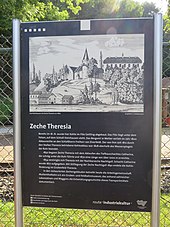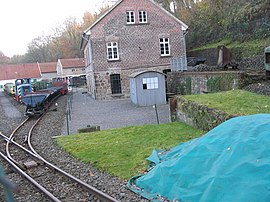Theresia colliery
| Theresia colliery | |||
|---|---|---|---|
| General information about the mine | |||
| Building of the Theresia colliery | |||
| other names | Teresia colliery Theresia colliery near Steinhausen Therese colliery Theresa colliery |
||
| Mining technology | Underground mining | ||
| Funding / year | up to 538 t | ||
| Information about the mining company | |||
| Start of operation | 1790 | ||
| End of operation | 1854 | ||
| Successor use | Nightingale colliery civil engineering | ||
| Funded raw materials | |||
| Degradation of | Hard coal | ||
| Geographical location | |||
| Coordinates | 51 ° 25 '41.9 " N , 7 ° 19' 34.3" E | ||
|
|||
| Location | Bommern | ||
| local community | Witten | ||
| District ( NUTS3 ) | Ennepe-Ruhr district | ||
| country | State of North Rhine-Westphalia | ||
| Country | Germany | ||
| District | Ruhr area | ||

The Zeche Theresia is a former hard coal mine in Bommern . The mine was also known under the names Zeche Teresia , Zeche Theresia bei Steinhausen , Zeche Therese and Zeche Theresa . The works of the mine were located below Steinhausen Castle in the nightingale hollow.
Mining history
The beginnings
Already in 1727 the Oberbergvogt König in Schwerte granted the mining rights to the Baron von Stäel zu Steinhausen and to Gerhard Peter Merklinghaus. In 1728 the mine was mentioned in the court records. In 1789 a mutation was made for the mine field. The expectation put in by the trades of the Eleanor and Nachtigall collieries on December 17th was intended to secure the trades the mining rights for a field that was adjacent to their own fields. The muted field had a size of 20 measures. In 1790 the muted field was already being mined . On April 11, 1791, a renewed request was made. In 1799 one found visual inspection of the field instead. On 17 May 1800 was a small length field for degradation in the seam Geitling awarded . The mine was put into operation on October 1, 1812.
Operation of the mine
From 1812 tunnel construction was carried out in the Geitling seam . A tunnel was set up below the Steinhausen house. However, there was only a low overall height . In the same year old, unknown mine workings were approached, for this reason operations were initially closed. In 1814 the mine was put back into operation and mining started again. In the same year a sliding path to the Ruhr was created. This path had a length of 286 laughs and was used to transport the coal mined above ground. In 1819 a ton-length shaft was in operation. In 1822 two coke ovens, so-called desulphurisation ovens, were put into operation. The ovens were used to produce coke for the mechanical workshops Harkort & Co. in Wetter. In 1823, mining began in the substation construction. In 1824 a contract was signed with the Nachtigall and Eleonore collieries to form a joint venture. On the basis of this contract concluded on July 15, part of the field of the Theresia colliery was separated and formed the operating community with the other two mines. The abutment tunnel was included in the operating community. By the year 1827 the coal reserves of the deposit were almost completely depleted. In the first months of 1830 a total of 538 tons of hard coal were mined. The Theresia colliery was shut down at the end of April.
The last few years until the shutdown

In 1832 the trades of the Zeche Theresia merged with the trades of other mines in order to move on to civil engineering . On the basis of the unification agreement concluded on April 25 of the same year, the mining below the bottom of the St. Johannes Erbstollen was regulated. This association was not a consolidation , but was closed in order to secure the extraction in the Neptun shaft for the parties involved in the contract. The mines involved remained independent above the St. Johannes Erbstollen sole. In 1835 the mine was out of order. In 1837, a small amount of mining was carried out below the bottom of the tunnel. On March 6 of the same year and on January 9, 1838, the authorized parts of the main seam and the western part of the secondary seam consolidated into the United Nightingale colliery. In the period from 1838 to 1844 the mine was idle, the reason for this being a strong water ingress. On February 15, 1848, a length field was awarded. In 1851, work began on the Catharina shaft, which took several tons. The shaft was sunk by the United Nightingale & Aufgottwag colliery and served to open up the counter wing of the nightingale trough. In 1854 the Zeche Theresia consolidated civil engineering with other mines to form the Zeche Vereinigte Nachtigall. After the Nachtigall colliery was shut down, operations in the Theresia field were also stopped.
Successor use and current state
After the Second World War, work began on the construction site of the Theresia colliery to sink a ton-long shaft. The shaft was created by the United Hamburg & Franziska colliery and was intended to extract remaining coal piers that are still below the Ruhr pastures. The shaft was east of the shaft Catharina set . However, the Ruhr gravel present there was encountered in the area. The ingress of water could not be stopped. Since it was not possible to seal the shaft sufficiently, the sinking work was stopped again at a shallow depth of 80 meters.
Today, a few day buildings, a mining tunnel and a ton-long shaft have been preserved from the Theresia colliery. The Theresia mine and field railway museum is located on the former site of the mine .
Individual evidence
- ↑ a b c d e f g h i j k Joachim Huske : The coal mines in the Ruhr area. Data and facts from the beginning to 2005 (= publications from the German Mining Museum Bochum 144) 3rd revised and expanded edition. Self-published by the German Mining Museum, Bochum 2006, ISBN 3-937203-24-9 .
- ↑ a b c d e f g h i Wilhelm Hermann, Gertrude Hermann: The old collieries on the Ruhr. 4th edition. Publishing house Karl Robert Langewiesche, successor Hans Köster, Königstein i. Taunus 1994, ISBN 3-7845-6992-7 .
- ↑ a b c d e f g h Nightingale colliery . In: City of Witten. (Ed.): Open Monument Day, Witten 2010
- ^ A b Gustav Adolf Wüstenfeld: Early sites of the Ruhr mining industry. Monograph on the history of the Ruhr area, Gustav Adolf Wüstenfeld-Verlag, Wetter-Wengern 1975, ISBN 3-922014-01-1
Web links
- Early mining on the Ruhr: Zeche Theresia (accessed on March 4, 2013)
- Early mining on the Ruhr: Historical map around 1840 (accessed on March 4, 2013)
- Early mining on the Ruhr: Map of the situation around 2000 (accessed on March 4, 2013)


